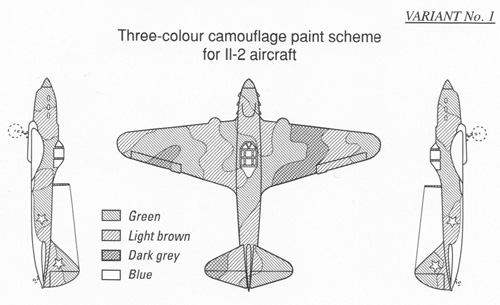
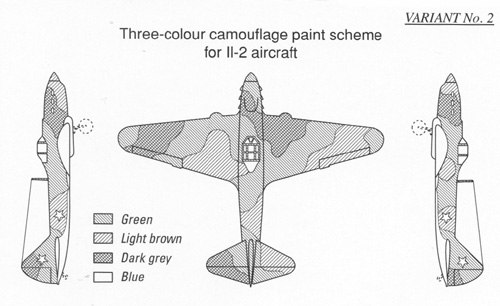
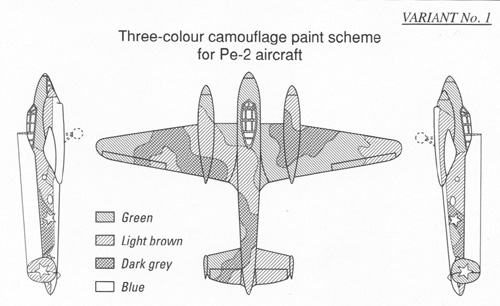
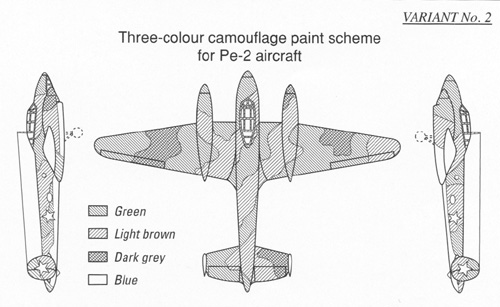
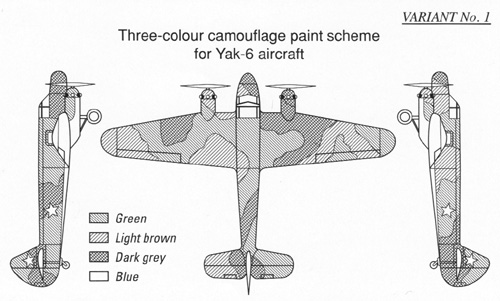
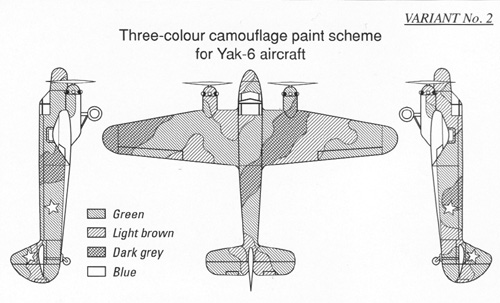
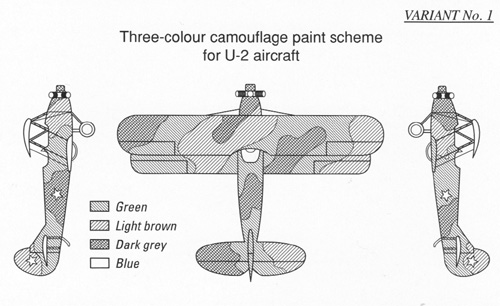
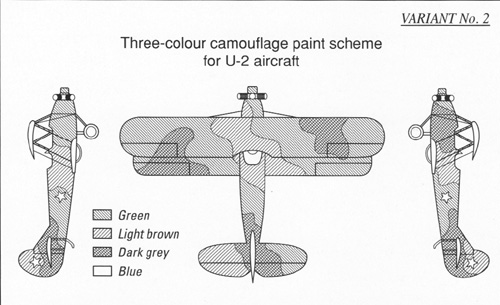

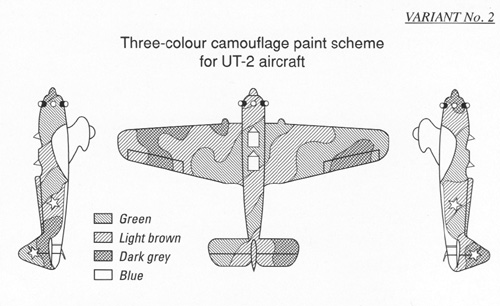
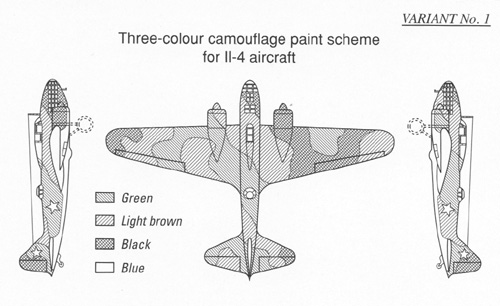
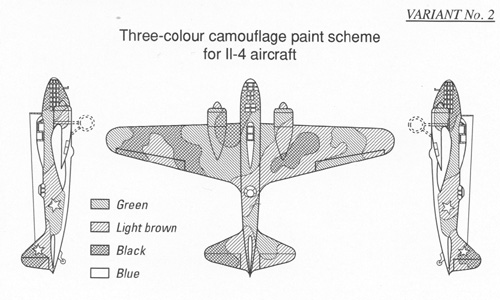
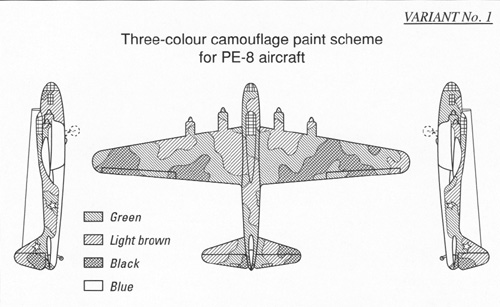
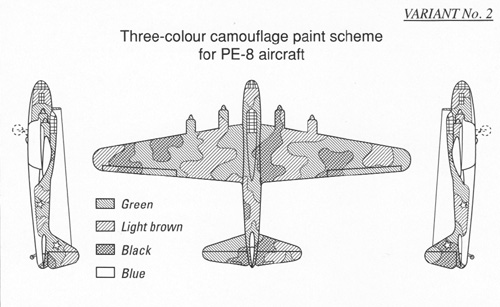
|
by Massimo Tessitori |
|
|
|
The black and green camouflage hurrily introduced in summer 1941 wasn't considered fully satisfactory, and many officers complained of it, also because black is not between the colors of the ground. In June 1942, 20 aircraft LaGG-3 built in factory n.21 and 20 Pe-2s bult in factory n.22 were painted with a 3-shade camouflage for testing purposes, and they obtained positive feedbacks when distributed to operative units.
The proposal was confronted with that of Major-General Losyukov, that proposed, in February 1943, a Yak-1 painted with a 3- shades scheme of AMT-4 green, AMT-6 black, AMT-1 light greyish brown. From the photo, we can see that the light brown has been brush painted over a factory painted black/green plane.
Another factor entered to influence the choice of a new standard camouflage during the early spring of 1943 was the lack of raw materials as lead and chromium oxide, both utilized for AMT-4 and A-24m green paints. Already in 1942 there was a directive about the use of one coat of green paint instead of the previously applied two coats to save paint; a further cut was necessary now.
These contrasting necessities led the Scientific Instiute of Air Force, NII-VVS, to make tests from June 20 to 27 of 1943, comparing these two planes plus a Yak-1 with standard green-black camo. These three planes were wiewed and photographed from many angles and distances and against different environmental backgrounds. The camouflage of Losyukov was chosen as the prototype of the new style of painting for non-fighter planes.
The directive n°2389/0133 of July 3, 1943, gave new instructions to paint the Soviet warplanes:
| Nitro lacquers for mixed construction planes | Oil enamels for all-metal planes | |
| light brown | AMT-1 | A-21m |
| dark green | AMT-4 | A-24m |
| black | not needed | A-28m (for Il-4 and Pe-8 only) |
| light blue | AMT-7 | A-28m |
| blue-grey | AMT-11 | not needed for non-fighter planes |
| dark grey | AMT-12 | A-32m |
The directive assumed that the non-fighter planes had to be delivered with the new camouflage starting from August 1, 1943; in the days before, black had to be replaced with dark grey.
In case of absence of dark grey, this would have been replaced by a mix of light blue and black.
The directive contained 15 camouflage schemes for many types, of which 14 were for non-fighter planes.
 |
 |
 |
 |
 |
 |
 |
 |
 |
 |
 |
 |
 |
 |
Note the lack of instructions for other types, as Li-2, Yer-2 and Tu-2.
Now, let's look how these templates comply with wartime photos. Unfortunately, the new camouflage had a low contrast and doesn't appear clearly on bw photos: the reflectivity of green and dark grey were very similar: grey was just a bit darker than green when new, and it faded more quickly, becoming undistinguishable or even lighter. From photos, it seems even that the light brown turned to dark brown with ageing. Sometimes it's hard to distinguish such camouflaged planes from all-green ones.
A thing that helps to distinguish this camo from green/black and grey-grey ones is that those had usually a 50%-50% distribution of colors (that is, so much green, so much black), while the 3-shades camo had clearly different percentages.
|
The standard templates were effectively employed on Il-2s, with some characteristics changing from factory to factory. In photos, they are recognizable mainly for the disposition of the brown bands on the fuselage. For unclear reasons (possibly related withb the paint type and thickness or to the exhaust stains), on photos, the brown bands on the rear fuselage and wings often appear lighter than the one on the front and mid fuselage. To know more, go to the IL-2 page. |
|
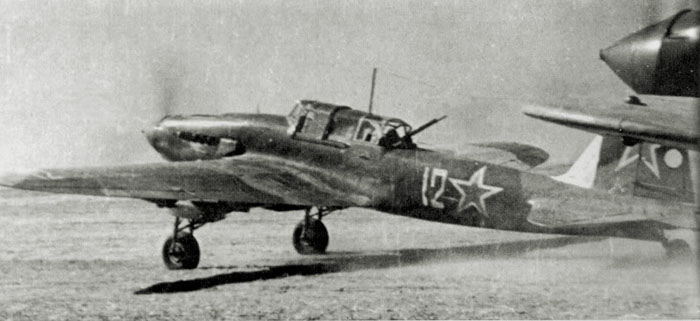 |
Planes built in Zavod 1 show an highly contrasted and sharp camouflage forthemost reproducing the first template; the puzzle-like contours on the right wing are easily recognizable when visible. The red stars were wide. Planes built in this factory have a characteristic fingernail shaped fairing on their tail wheel. Photos of planes apparently built in Zavod 1 with the second template often show more blurried bands contours than those following the first template. |
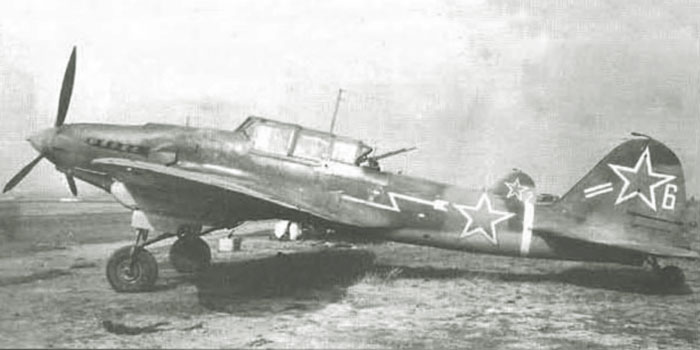 |
Planes built in Zavod 18 were less standardized, scarcely following the templates and with many individual variations. Some of these planes don't show the characteristc brown bands on the fuselage, but a vertical one covering the rudder. These planes bear a thin fairing to the tail wheel leg, sharp and without flexible cover. |
|
Planes built in Zavod 30 wear both the 1st and the 2nd standard templates, but the bands on the wings were simplified, blurried and had contours roughly parallel to the flight axis. The red star were somewhat smaller. These planes often bear a flexible cover on the tail wheel leg. and a thin fairing. |
|
|
Having been put in production in mid 1944, Il-10s roughly followed the templates of Il-2s. To know more, go to the Il-10 page.
|
|
|
Many photos show Il-2s camouflaged according to the templates of 1942. Note that they considered the use of black instead of the dark grey prescribed for many other types, and many photos show really a contrast confirming the use of black. The undersurfaces were painted 'noch' deep black for night bombing.
Not all the planes in photos are compatible with these patterns; other ones seem to follow their own pattern, other ones are scarcely contrasted because of the use of dark grey instead of black in the camouflage. Many photos depict planes with the former black-green camouflage modified with the addition of brown and the new style natinal markings after August 1943.
To know more, go to the Il-4 page. |
|
Pe-2s after August 1943 appear to have been painted roughly following the standard templates. The plane of the photo on the right seems painted according to the first template, but on some parts the grey looks lighter than the green.
I have not good photographic evidence of application of the second template, considering the presence of two brown bands on the mid fuselage as a distinctive characteristic. The photo above is what seems more similar, but has important differences and could be due to a later repainting, noteworthy avoiding the rudders. |
|
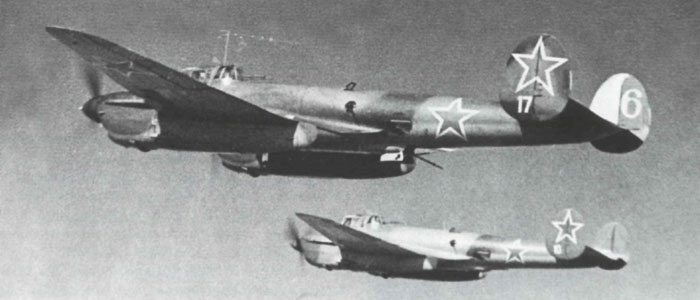 |
Many photos depict black-green Pe-2s modified with the addition of light brown, particularly on the mid fuselage, and new style markings after August 1943 to fit the new standards. |
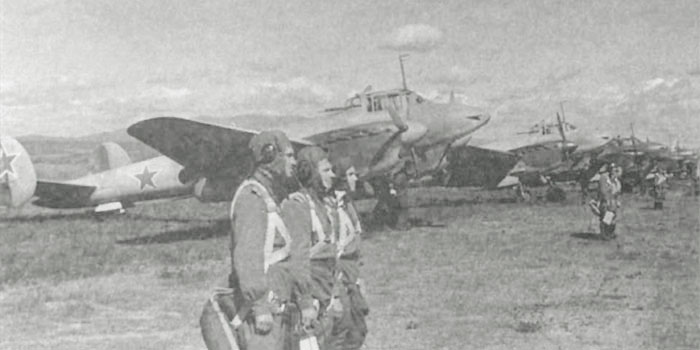 |
Many Pe-2s appear to have been repainted with a mysterious light color in late 1944 and 1945. This light finish often excludes the rudders, the engine cowlings and sometimes the canopy area. Reports of veterans speak of the existance of Pe-2s painted with solid grey finish, so this could be a way to comply to some not well known order of the commands.
To know more, go to the Pe-2 page |
|
The document of NKAP doesnt provide templates for 3-shades camouflaging of Tu-2s, but here on the right is a factory sketch (From Vaklamov and Orlov). Unfortunately, photos seem to show that wasn't accurately followed.
This photo of 1947 shows a fairly good, but not perfect, correspondance to the factory template, apart that the areas that should be dark grey appears lighter than those that should be green; perhaps this is due to a quicker fading of the dark grey. It could be casual, but the left rudder and stabilizer appear as for a black/green painted plane, a thing that was often observed on photos of 1943/45 Tu-2s and suggests the use of AMT-6 black and AMT-4 green on the vertical surfaces. |
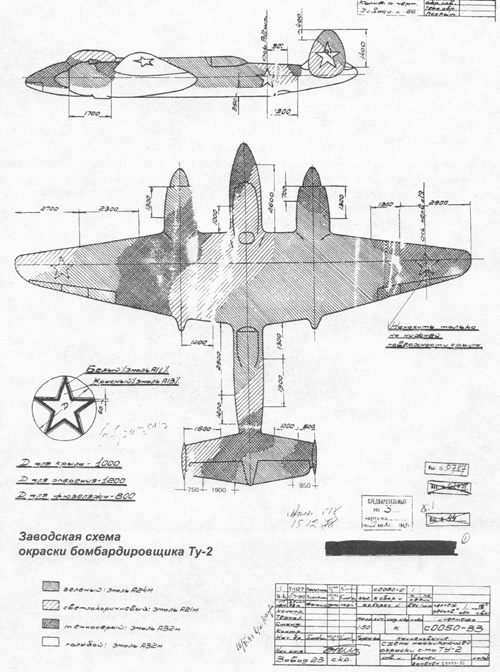 |
 |
A photo of late 1944. Lots of photos show a partial correspondance to this pattern in the rear part of fuselage, while the wings look very light and uniform. The reason of this is not clear: is this due to the different fading of colors on different parts, or we can hypothize a light color repainting as evident on many photos of Pe-2? If so, is the added-on color grey?
To know more (and be more confused) go to the Tu-2 page
|
UT-2 and UT-2M
Rare photo of an old UT-2 repainted with the new 3 shades camouflage, in good concordance to the 1st template.
This plane seems to show a post-1943 star with white outline on the fuselage, and an unidentified camo scheme possibly compatible with the second template.
|
|
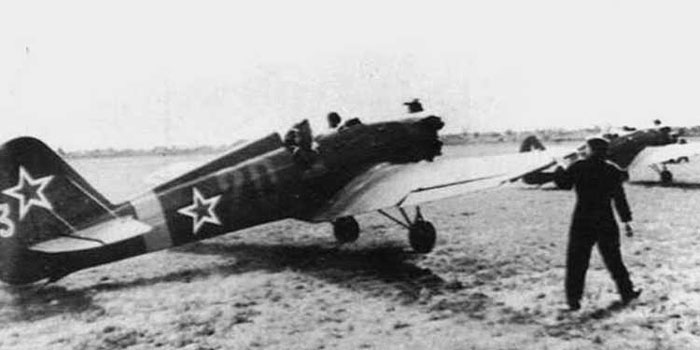 |
Another old UT-2 after 1943. It seems to bear the old-style black-green canouflage. Noteworthy are the markings, with post-1943 stars, a (light blue?) band and (red with white thick outline?) number 3 on the tail, and a wide red 20 on the mid fuselage. |
U-2 The use of both the templates of 1943 on U-2s (now called Po-2s) is well compatible with photographic evidence.
|
|
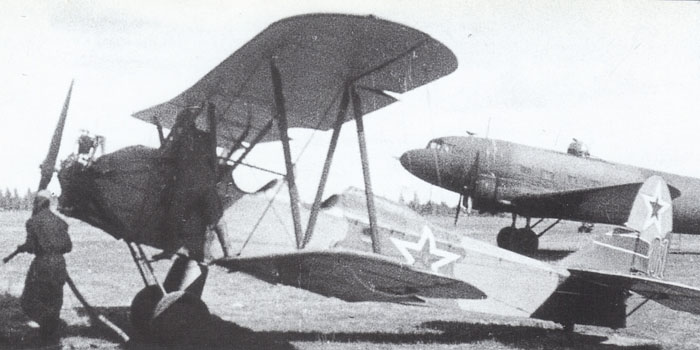 |
There are photos of Po-2s of 1944/45 with a two shades camouflage. Some author interpretates them as a brown/green scheme (never described on known official instructions). Another interpretation is that they were painted in a two grey livery (AMT-11 and 12) as officialized by the NKAP instructions of 1945, although in a less sharp-edged form. |
ShCh-2
|
This transport plane ShCh-2 is painted in a three-colors camouflage according to a template that looks different than all other types of two-engined planes. Unfortunately this is the only available image of this camo till now. |
|
The (poor) photographic evidence demonstrates the application of the first template of 1943 on this type. The strong contrast between the (nominally) grey and green bands suggest that, on this plane, the grey AMT-12 could have been replaced by ANT-6 black.
No any photo is available of planes painted according to the second template, but it's possible that this camo was utilized too. |
|
|
Apparently, this Yer-2 white 1 follows a 3-shades camouflage. The 3 colors are well distinguishable on the rear fuselage and tail. An interpretation of the camo scheme of white 1, traced with the help of the 1st template of 1943 for Pe-2, that looks compatible enough. Yer-2 have followed the templates for Pe-2 of 1941 and 1945 too.
This nosed-down plane shows its upper camouflage, scarcely contasted but interpretable with the help of the 2nd template of 1943 for Pe-2. Unfortunately the fuselage numbers aren't visible at all. Spinners could be painted with some bright color. An interpretation of the camo of the plane photographed above, traced with the help of the 2nd template for Pe-2, that looks compatible enough.
To know more, go to the Yer-2 page. |
|
|
From the few photos available, Pe-8s seem to have painted with scarce respect to the standard templates.
This Pe-8 AM-35 seems to have a standard black-green camo of 1941 modified with some light brown.
This Pe-8 ASh-82 looks to show only a partial resemblance to the first template |
|
|
The NKAP instructions of 1943 didn't include any sketch for this type. From the photos available, we see that the factory adapted their previous camouflage style by inserting some light brown bands, not always on the same positions, and replacing black with dark grey. Note the use of'noch' deep black on the undersurfaces, in considerations to the fact that many of these planes were adapted as night bombers. Right: an indicative drawing of a typical camouflage of a Li-2 after August 1945.
To know more, go to the Li-2 page |
|
Camouflage paints for Soviet shturmoviks, bombers and
transport planes, September 1943 - 1945
| name of paint | indicative chip | match | typical use | notes |
| A-26m matt black |
 |
FS-37038 (2,3)
AKAN 343 |
Upper surfaces black-brown-green camouflage
(Pe-8, Il-4)
|
Oil paint for all-metal planes equivalent to AMT-6 |
| AMT-4 matt camouflage green |
 |
FS-24102, 24151 (2,3)
AKAN 301 |
Upper surfaces gray-brown-green camouflage(Il-2,
Po-2, UT-2, Yak-6)
|
Nitrocellulose lacquer for mixed construction planes |
| A-24m matt camouflage green |
 |
FS-34102, 34151 (2,3)
AKAN 301 |
gray-brown-green camouflage (metal Il-2,
Il-10, Pe-2, Ye-2, Tu-2)
black-brown-green camouflage (Pe-8, Il-4)
|
Oil paint for all-metal planes equivalent to AMT-4 |
| AMT-1 matt light greyish brown |
 |
FS-26306 (2,3)
AKAN 300 |
gray-brown-green camouflage(Il-2, Po-2,
UT-2, Yak-6...)
|
Nitrocellulosic lacquer. According to some sources, it started with a greyish dominant, then specificaton changed and became more brown (see here and here) |
| A-21m matt light yellowish brown |
 |
FS-34201, 36350 (2,3)
AKAN 379 |
gray-brown-green camouflage (metal Il-2,
Il-10, Pe-2, Ye-2, Tu-2)
black-brown-green camouflage (Pe-8, Il-4)
|
1943-1945 oil paint for all-metal planes similar to AMT-1 but more yellowish (see here and here) |
| AMT-12 matt dark grey |
 |
FS-27003 (2,3)
AKAN 345 |
gray-brown-green camouflage(Il-2, Po-2, UT-2, Yak-6) | 1943-1945 Nitrocellulosic lacquer for mixed construction planes |
| A-32m matt dark grey |
 |
FS-36081 (2,3)
AKAN 345 |
gray-brown-green camouflage (metal Il-2, Il-10, Pe-2, Ye-2, Tu-2) | 1943 and later oil paint for all-metal planes |
| AMT-7 matt greyish blue |
 |
FS-25190
AKAN 302 |
Undersurfaces of mixed construction planes
(Il-2, Po-2, UT-2, Yak-6...)
|
Nitrocellulose lacquer for mixed construction planes
|
| A-28m matt greyish blue |
 |
new FS-34533 (1,6)
aged FS-34533 (2,3) |
Undersurfaces of all-metal planes (metal Il-2, Il-10,
Pe-2, Ye-2, Tu-2, Il-4, Pe-8...)
|
Oil paint for all-metal planes
equivalent to AMT-7 (or to AII blue?) |
| MK-8 and “Noch” (night) matt black |
 |
(1) | undersurfaces of night bombers | 1942 -1945 permanent, darker than AMT-6 |
Note: this type of three-colors camo is often difficult to distinguish on photos,
possibly because of the fading of the dark greys and the darkening of light browns,
and could be mismatched with a two-shades camo or even with uniform green.
|
|
Image of the wreck an all-metal wing of Il-2 recovered near Pinemyra. The camouflage is compatible with the standard 1943 template of green, light brown and dark grey, but colors altered in different way: green has become lighter and bright, dark grey has become light grey and light brown has darkened. |
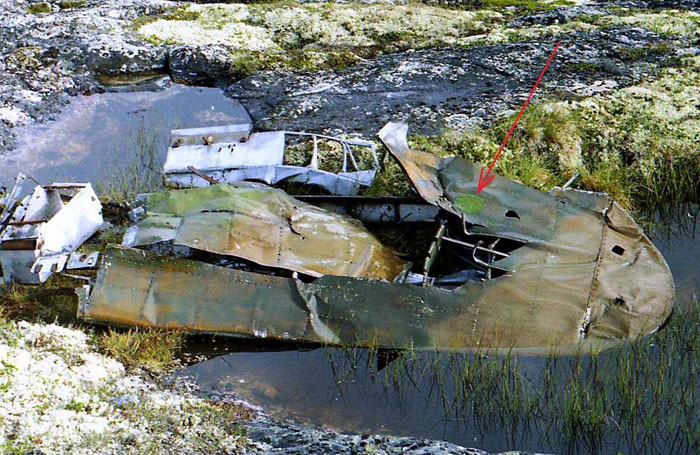 |
Another piece of wing of an Il-2 with the 3-shades scheme. |